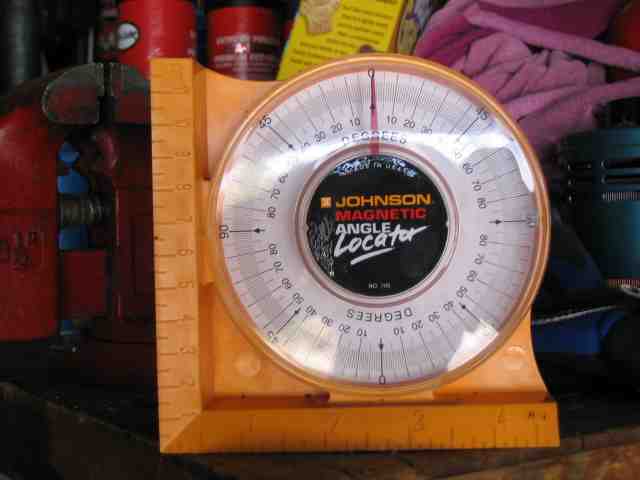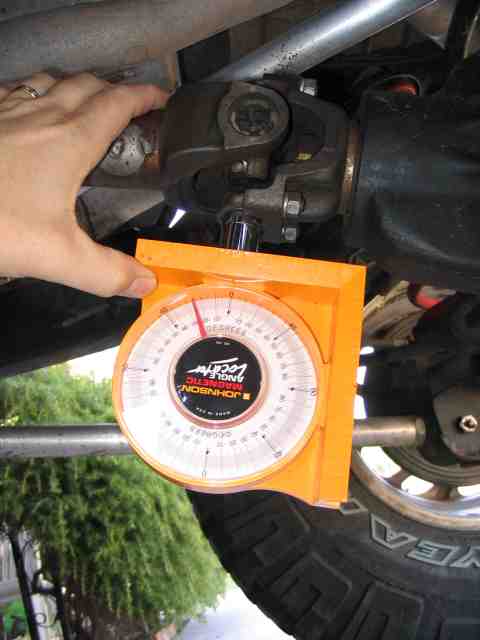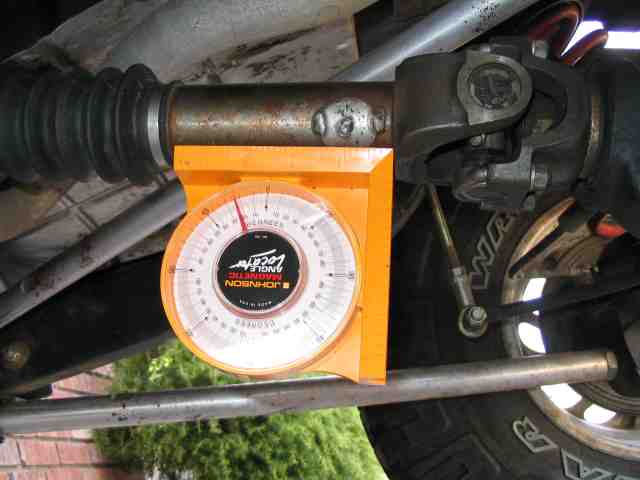So you have installed your brand new slip yoke eliminator (SYE) on your transfer case and you just finished tightening the bolts on your new double cardan drive shaft (also called a constant velocity or “CV” drive shaft). Before you decide to take it out for a test drive, you need to adjust the pinion angle of your rear driveshaft so that you will not have any vibrations. How do you do that?
Most folks use a pair of upper adjustable control arms to help with the alignment. The upper arms are adjusted to be a bit longer than the stock upper control arms. This causes the top of the axle housing to rotate towards the rear of the vehicle which lifts the pinion up. We want to lift it enough so that it is in direct alignment with the drive shaft. The taller your lift, the more you will need to rotate your axle housing to get the pinion into proper alignment.

Some folks are lucky and they can look at the drive shaft and pinion and tell when they are set up correctly. Me….well, my calibrated eyeballs gave out some time ago so I have to rely on an angle finder. The pic above shows the one I use. Nothing very fancy….I think it was about $7 at the local Home Depot store. It has a magnet built into the base which makes it easy to stick it onto the drive shaft and still leave both hands free for doing something else.

I’ve read a variety of comments in various forums about the best place to measure pinion angle….some of them I have yet to figure out. I prefer to measure it directly at the pinion, where I am guaranteed an accurate measurement.
NOTE: Although it should be obvious, you need to have the full weight of your vehicle on your axles. You can NOT do this adjustment when your vehicle is up in the air, supported by the frame, on a vehicle lift.
Before you attach the angle finder, roll the vehicle forward or backward until one end of the pinion yoke is parallel to the ground, as shown in the above picture. Grab a socket from your toolbox. Get one that will just fit onto the end of the u-joint cap….this u-joint cap will be pointing directly towards the ground. Place one of the flat edges of the angle finder against the socket. I use the magnetic side as it helps hold things in place. Make sure you have everything lined up squarely and all the components are flat against each other. Note your pinion angle. The angle above is right at 25 degrees on my pinion.

Next, you need to find the drive shaft angle. On my drive shaft, I have a spot, as shown above, where the shaft is perfectly flat AND the magnetic side of the angle finder can fit flush/flat on the tube. If yours is not like this, you can simply roll your vehicle just enough to rotate the pinion 90 degrees. This will position one end of the drive shaft’s yoke such that it is parallel to the ground. You can then use the socket and angle finder as you did before when checking the pinion’s angle but using the drive shaft yoke this time.
The angle above, for the drive shaft, is also 25 degrees. And so, my pinion and drive shaft are directly in-line with each other. There is NO angle at the pinion u-joint, which is what you want when using a CV drive shaft. All of the angle is taken up in the double cardan joint (the two u-joints at the other end of the drive shaft).
Some folks prefer to have the pinion angle about 1 degree less than the drive shaft angle. The reasoning here is that when you apply power to the rear axle, it will load the rear axle a bit and the pinion will lift a small amount. I don’t have a problem with this and if you want to set yours up that way, it is just fine. I have cartridge joints on my lift and so there is no rubber bushings to compress when power is applied….so I really won’t see much of a pinion angle change when I apply power to the rear axle. If this were a YJ, with leaf springs, then you would want to set your pinion several degrees below the drive shaft as the springs will allow some axle wrap which will cause the pinion to lift upwards when power is applied.
If your angle is not correct, then you must adjust your upper control arms a bit to “dial in” your pinion position. If the angle on your pinion is several degrees less than the drive shaft, then you need to lengthen your upper arms a bit to bring your pinion and drive shaft closer into alignment. You may have to check and make these adjustments several times before you have everything set up correctly. Some folks get lucky and get it right on the first try.
That is about it! Nothing much more to it than just that….but it is important that you get your pinion angle set up correctly. Failure to do so can and does result in vibrations, pinion seal leaks, pinion bearing problems, and early u-joint failure. Take your time and do it right. You’ll appreciate the trouble free service your new SYE and CV drive shaft provide you.